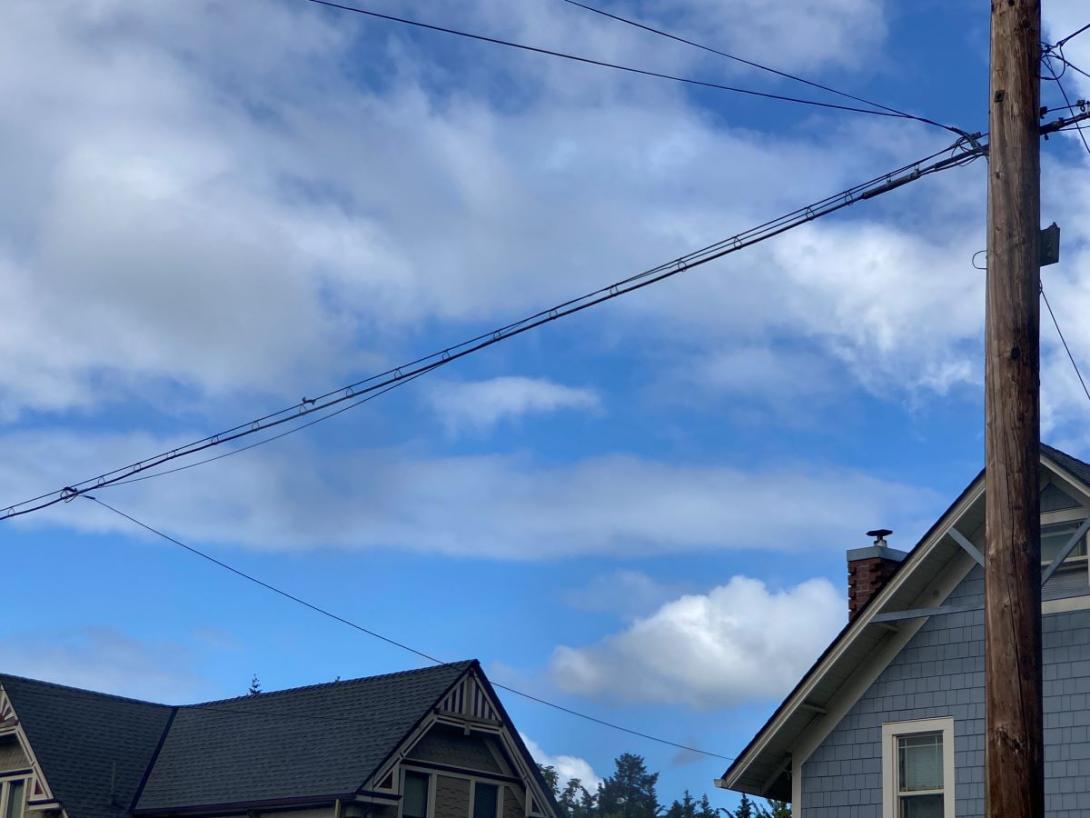
Lead from old telecom cables is leaching into Portland neighborhoods, a new study has found.
Researchers found moss growing near lead-sheathed telecommunications cables in older Portland neighborhoods contained lead levels as high as 590 times that of moss in rural areas outside the city.
The study raises concerns about a long-ignored source of lead, which can cause medical issues and impair neurological development in children.
Lead-sheathed cables have been largely phased out since the 1960s, but many remain, continuing to drip lead onto plants below. Moss isn’t a likely source of lead exposure for humans, but researchers sampled it to see how environmental lead levels vary across the region.
Alyssa Shiel, an associate professor at Oregon State University and the lead author of the study, said the next phase of the research will look at the soil under these cables. Lead-contaminated soil often becomes airborne dust, which can be lifted into the air by traffic or wind.
“We want to do this because it's the likely route of exposure, people inhaling or ingesting lead contaminated soil,” Shiel said.
The study doesn’t suggest that lead cables are a leading cause of elevated blood lead levels, but it adds another potential culprit to the laundry list of lead sources that public health investigators can examine when a child is found to have elevated levels of lead in their blood.
“These neighborhoods that have these older cables in them also have a lot of other reasons to be concerned about lead.”
Nationally, the primary source of lead exposure in children is thought to be ingesting lead-based paint, which was banned in the late 1970s but still remains on the walls of many homes, where it can crumble into dust or mix with dirt outside.
And lead from leaded gasoline, banned nearly 30 years ago, is still found in moss and in dirt.
“These neighborhoods that have these older cables in them also have a lot of other reasons to be concerned about lead,” said David Farrer, a toxicologist in the Oregon Health Authority’s Environmental Public Health Section.
“There's lead in, unfortunately, a lot of places, and we try to be aware of all of them,” Multnomah County Health Department lead specialist Perry Cabot said. With the new study, “we’re now aware of one more,” Cabot said.
Health effects can be subtle, serious

Lead exposure often doesn’t show any obvious signs or symptoms right away. Blood lead levels drop once exposure ends, but if families aren’t aware of ongoing exposure, they can’t make changes.
“What we most worry about is neurodevelopmental problems, like subtle decreases in IQ or later-in-life behavioral problems,” Farrer said. “If you have those low-level exposures when they are young and their brains are still developing, then that can pose a risk later in life, which is why the screening is so important.”
When public health workers learn of a high blood lead level in a child or pregnant person, their job is “trying to establish what is the most probable source of lead exposure for that child, and then providing recommendations to reduce or eliminate those exposures,” OHA Lead Poisoning Prevention Program Coordinator Ryan Barker said. Children then get follow-up blood lead testing every three months to make sure levels are going down. “And if they’re not, that tells us that exposure is still happening. And there's more work that we need to do.”
Children on the Oregon Health Plan, or Medicaid, are required to get blood lead tests at 1 year and 2 years old, or before they turn 6, if they weren’t previously tested. But fewer than one in ten children under the age of 3 on OHP have been tested, Barker said.

Parents with children on private insurance are supposed to complete a screening questionnaire and get the child tested if they’re deemed at risk for lead exposure, but testing rates are similarly low.
“Whether it's heavy diesel emissions in a neighborhood or this lead exposure, there's always hundreds of individual stories that are playing out what the statistics say,” Neighbors for Clean Air co-executive director Mary Peveto said. “Children, cognitively, are impacted by lead. Children are developmentally impacted by breathing bad air, and yet those families dealing with those children are stuck in struggles and cycles of day-to-day problem solving that could be enhanced if they actually knew what was causing the problem.”
Shiel, the researcher, said “One great outcome of this study would actually be if we overall could increase blood lead level testing for children in the state … We don't know how many children being impacted by lead exposures are missed.”
“Children, cognitively, are impacted by lead. Children are developmentally impacted by breathing bad air, and yet those families dealing with those children are stuck in struggles and cycles of day-to-day problem solving that could be enhanced if they actually knew what was causing the problem.”
The study, co-authored by Shiel, Sarah Jovan of the U.S. Forest Service and Christina Murphy of Oregon State, was published in the scientific journal Communications Earth & Environment in July 2024. The study initially started a decade ago, but researchers couldn’t figure out an explanation for hotspots spread around the city in residential areas until a 2023 Wall Street Journal investigation exposed the contamination caused by lead-sheathed cables across the country.
A study website also shows how to identify lead-sheathed telecommunications cables and how to reduce lead exposure where those cables are present.
According to a state spokesperson, DEQ does not have jurisdiction over telephone cables. The U.S. Environmental Protection Agency has waived the lead monitoring requirement for DEQ since 2023 because lead in ambient air had decreased significantly, according to a DEQ annual report.
The Oregon Department of Environmental Quality “is and will continue to stay in touch with OSU researchers on this topic,” DEQ spokesperson Lauren Wirtis said.
You can reach Anna Del Savio at [email protected] or via x.com at @annadelsavio